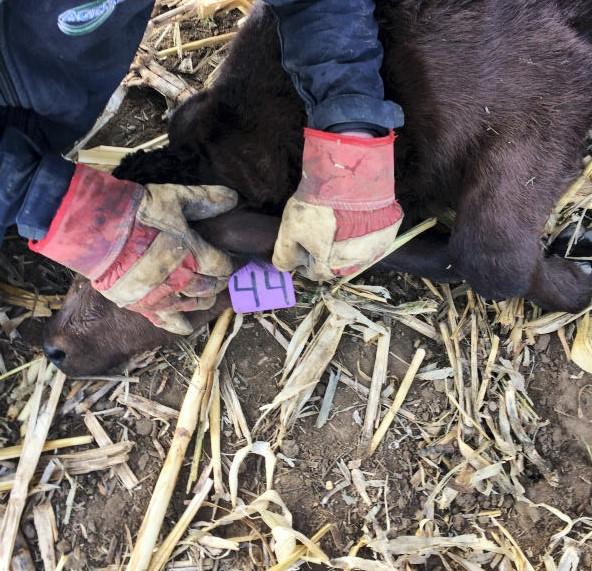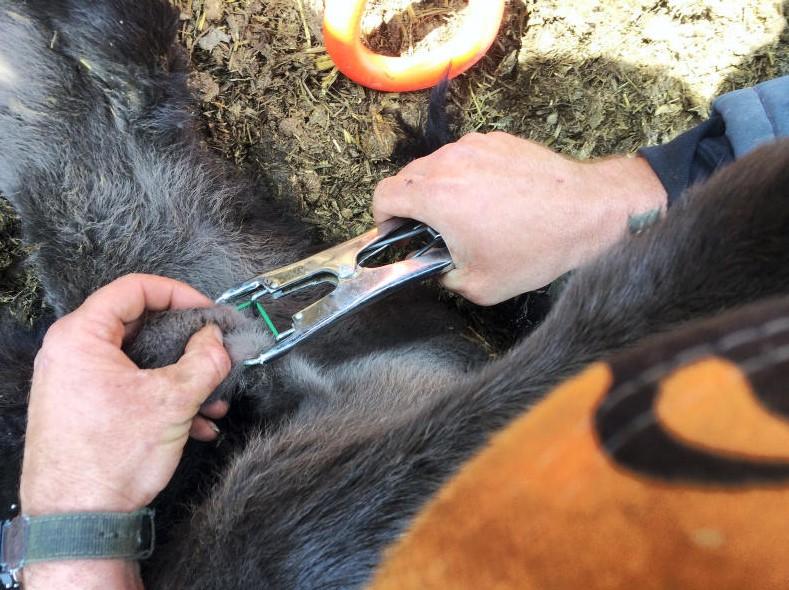My name is Jack O’Donnell. I’m from Co Waterford and I am in my third year of the agricultural science degree in UCD.
I’m studying animal and crop production and I am currently on work experience on a beef and tillage farm in Saskatchewan, Canada, for two months.
The farm I’m on is in Kincaid, Saskatchewan, Canada, and is owned by Dustin Hawkins, who, in addition to 9,000 acres of crops, runs a large suckler-to-beef herd on 20,000 acres of grassland.
On the farm right now there are 650 suckler cows, 650 calves, 200 Angus/Simmental heifers and 32 Simmental and Angus bulls.
Dustin sells steers at 10 months after fattening them on grass and creep feed.
Temperatures here drop as low as -30°C in winter and rise to 35°C in summer.
At the moment, there are about 580 cows calved and another 50 yet to calf. The mortality rate of calves so far is as a low as 3%.
Temperatures here drop as low as -30°C in winter and rise to 35°C in summer.
The calving season begins in March when temperatures begin to rise, but it can still be as cold as -8°C. Cows calve out in the pens and usually have very little trouble.
Calving and tagging
During peak calving, there would be up to 120 cows calving each week. Once born, each calf is tagged with a tag that matches their mother’s number and colour. These calves and their mothers are moved out of the calving pen as soon as they can walk and into the next pen, where they are held for a few days.
At four days old, the calves are then tagged with an electronic tag and any steer calf is banded with a rubber ring. These cows and calves are then moved into a 20-acre pasture where the cows are fed and the calves have access to shelter huts.
Adjacent to the 20-acre pasture is a 50-acre maize field which the animals have access to. At this time of the year most of the maize field has been eaten, but the cows eat this to the ground. The cows are also fed with the diet feeder and are given 300lb of molasses, 1,000kg of chopped hay and 20,000kg of wholecrop silage consisting of barley, oats and peas.
I was on the diet feeder over the past few days.
Each morning we drive through the cows and calves using a gator. Any sick calves, for example with scour, are caught and given a scour tablet.
Dustin has 20,000 acres of grassland for his animals, most of which is rented
Once all the cows have calved, they are moved with their calves 80 miles to grassland, where they will remain until October.
Dustin has 20,000 acres of grassland for his animals, most of which is rented.
It sounds huge when compared with Ireland, but this area in Canada has an average stocking rate of 20 cattle to 160 acres. Most of the pastures are native grasses, with very little reseeding done and also very little use of fertilisers.
Hormones
In Canada the use of hormones is permitted. All the steer calves are given a hormone into the ear before they leave the farm for the outside grassland. These steer calves are creep-fed throughout their time on the grassland and they are sold at 10 months, at an average weight of 410kg.
Heifer calves are reared separately to the steer calves. They are not creep fed, but are put on a high-quality diet of ad-lib wholecrop silage and up to 5kg of rolled barley per day.
The goal is to have the heifers at a weight of 480kg by 14 months, when they are put in calf to Angus bulls.
The breeding regime on Dustin’s farm is very tight. Only the best heifers are put in calf and the rest are sold. Angus bulls run with the heifers for 30 days and any heifers who are scanned not in calf are culled or sold.
The breeding season for the cows is not as tight as the heifers and they will run with Simmental bulls for 50 days. Again, any of these cows not in calf after scanning are culled from the herd.
Branding calves
Each and every calf on the farm is branded with DH (Dustin Hawkins) on their side. It is done with an electric branding iron.
It is very physical work as the calves all have to be caught and turned on their side. Once they are grounded, it takes two people to hold the calf down. Two people work the branding irons, holding the iron on the calf for approximately 10 seconds until the brand can be seen.
The calves are also injected for IBR, BVD and Blackleg, and the steers are injected with a hormone into the ear.

Branding day has to be the busiest day I’ve worked here so far and there was plenty of help on the day. There were at least 12 people involved with the whole process, even children as young as seven who were able to hold down some small calves.
Jack O’Donnell is an agricultural science student at UCD and is travelling as part of his professional work experience (PWE) programme. Jack is a winner of the Agricultural Science Association – PWE Travel Bursary Award, which is supported by the Irish Farmers Journal.
Read more
Watch: Farmer Writes – following the harvest across America
Student blog: some top tips for working in New Zealand
Watch: camera at the mart in Mankota, Saskatchewan, Canada
My name is Jack O’Donnell. I’m from Co Waterford and I am in my third year of the agricultural science degree in UCD.
I’m studying animal and crop production and I am currently on work experience on a beef and tillage farm in Saskatchewan, Canada, for two months.
The farm I’m on is in Kincaid, Saskatchewan, Canada, and is owned by Dustin Hawkins, who, in addition to 9,000 acres of crops, runs a large suckler-to-beef herd on 20,000 acres of grassland.
On the farm right now there are 650 suckler cows, 650 calves, 200 Angus/Simmental heifers and 32 Simmental and Angus bulls.
Dustin sells steers at 10 months after fattening them on grass and creep feed.
Temperatures here drop as low as -30°C in winter and rise to 35°C in summer.
At the moment, there are about 580 cows calved and another 50 yet to calf. The mortality rate of calves so far is as a low as 3%.
Temperatures here drop as low as -30°C in winter and rise to 35°C in summer.
The calving season begins in March when temperatures begin to rise, but it can still be as cold as -8°C. Cows calve out in the pens and usually have very little trouble.
Calving and tagging
During peak calving, there would be up to 120 cows calving each week. Once born, each calf is tagged with a tag that matches their mother’s number and colour. These calves and their mothers are moved out of the calving pen as soon as they can walk and into the next pen, where they are held for a few days.
At four days old, the calves are then tagged with an electronic tag and any steer calf is banded with a rubber ring. These cows and calves are then moved into a 20-acre pasture where the cows are fed and the calves have access to shelter huts.
Adjacent to the 20-acre pasture is a 50-acre maize field which the animals have access to. At this time of the year most of the maize field has been eaten, but the cows eat this to the ground. The cows are also fed with the diet feeder and are given 300lb of molasses, 1,000kg of chopped hay and 20,000kg of wholecrop silage consisting of barley, oats and peas.
I was on the diet feeder over the past few days.
Each morning we drive through the cows and calves using a gator. Any sick calves, for example with scour, are caught and given a scour tablet.
Dustin has 20,000 acres of grassland for his animals, most of which is rented
Once all the cows have calved, they are moved with their calves 80 miles to grassland, where they will remain until October.
Dustin has 20,000 acres of grassland for his animals, most of which is rented.
It sounds huge when compared with Ireland, but this area in Canada has an average stocking rate of 20 cattle to 160 acres. Most of the pastures are native grasses, with very little reseeding done and also very little use of fertilisers.
Hormones
In Canada the use of hormones is permitted. All the steer calves are given a hormone into the ear before they leave the farm for the outside grassland. These steer calves are creep-fed throughout their time on the grassland and they are sold at 10 months, at an average weight of 410kg.
Heifer calves are reared separately to the steer calves. They are not creep fed, but are put on a high-quality diet of ad-lib wholecrop silage and up to 5kg of rolled barley per day.
The goal is to have the heifers at a weight of 480kg by 14 months, when they are put in calf to Angus bulls.
The breeding regime on Dustin’s farm is very tight. Only the best heifers are put in calf and the rest are sold. Angus bulls run with the heifers for 30 days and any heifers who are scanned not in calf are culled or sold.
The breeding season for the cows is not as tight as the heifers and they will run with Simmental bulls for 50 days. Again, any of these cows not in calf after scanning are culled from the herd.
Branding calves
Each and every calf on the farm is branded with DH (Dustin Hawkins) on their side. It is done with an electric branding iron.
It is very physical work as the calves all have to be caught and turned on their side. Once they are grounded, it takes two people to hold the calf down. Two people work the branding irons, holding the iron on the calf for approximately 10 seconds until the brand can be seen.
The calves are also injected for IBR, BVD and Blackleg, and the steers are injected with a hormone into the ear.

Branding day has to be the busiest day I’ve worked here so far and there was plenty of help on the day. There were at least 12 people involved with the whole process, even children as young as seven who were able to hold down some small calves.
Jack O’Donnell is an agricultural science student at UCD and is travelling as part of his professional work experience (PWE) programme. Jack is a winner of the Agricultural Science Association – PWE Travel Bursary Award, which is supported by the Irish Farmers Journal.
Read more
Watch: Farmer Writes – following the harvest across America
Student blog: some top tips for working in New Zealand
Watch: camera at the mart in Mankota, Saskatchewan, Canada







 This is a subscriber-only article
This is a subscriber-only article









SHARING OPTIONS: